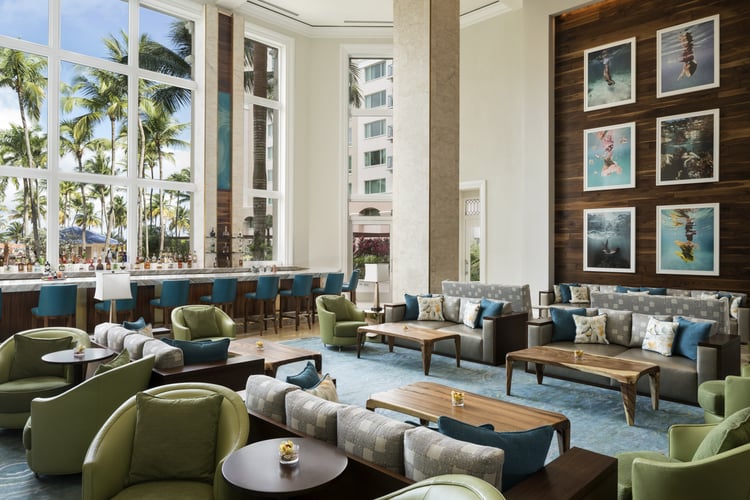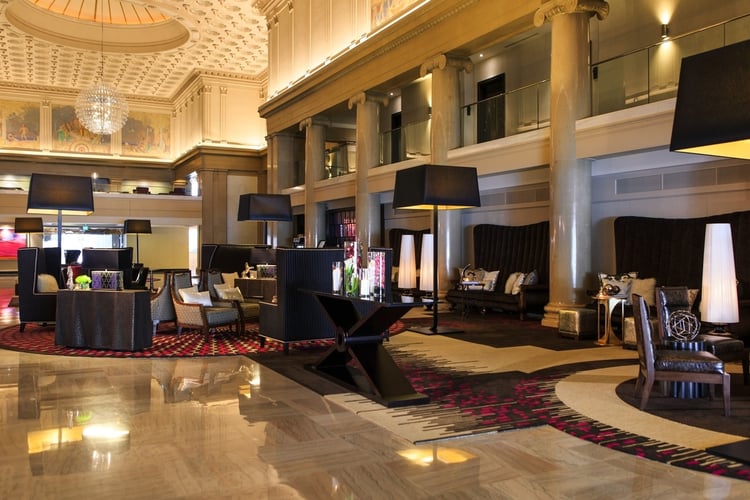There has been a big shift in hospitality during the last five years. Public spaces in hotels, especially the lobby, are officially the front and center attraction. While they have always been the first thing guests see, there is a new focus. This relates to setting the stage for experience while simultaneously creating engaging spaces where people want to hang out, and importantly, spend money.
 Ritz Carlton San Juan Puerto Rico - Streetsense
Ritz Carlton San Juan Puerto Rico - Streetsense
Therefore, it is no surprise; the hyper focus being placed on this space is pushing the design community to be more creative than ever to invent memorable places that resonate with consumers. To learn more, we spoke with three design focused companies on how they approach maximizing opportunity for their hotel owners’ clients in public spaces.
Do millennials drive the lobby design? We see a lot of millennial trends but how much, if any, do they impact your design?
“We see a lot more lobby spaces that are multi-function spaces. They are moving away from the traditional bar with lounge seating and reception area to more interactive spaces that feel authentic and connected to the neighborhoods they are a part of,” says Jason Maringola, Design Director, Interior Architecture at Streetsense.
“Millennials appreciate the technology and instant gratification of the lobby experience, but so does everybody nowadays. It isn’t just about catering to one group, it’s catering to a large group of people as a whole,” says Christina Skopliak, Creative Director, Design Force Corporation.
How much are owners involved on design aspects of the public space?
“It depends on the individual client. Many times, we have clients that are very sophisticated and are very involved, but it is very project dependent,” said Kathy Chavez, Senior Associate and Team Leader at Leo A. Daly.
Her colleague Lara Rimes, Senior Associate and Senior Designer with Leo A. Daly, says ownership involvement may change throughout the design process. “Often some of our clients want to be directly involved in the first few phases of the project and then they trust us to complete the project per their vision. Other clients want to be involved throughout the entire design process.
Marginola states at Streetsense they prefer having the owner involved at the start of the project. “We try to include ownership and brands to be a part of the process throughout. This allows us to understand the dos and don’ts of the space while allowing us to enforce the brand’s standards.”
How much focus do you put into public spaces when designing the property, and how does it drive the overall tone of the hotel property?
“When we design a project, there’s always a connection between the lobby and the guestroom. We create a mood board, and some conceptual and lifestyle images. These drive the feel of the space from top to bottom. Then we specifically isolate what the public space and guestrooms should feel like. They are very different; sometimes it’s an exciting and engaging public space, while the guestrooms are then more calming, soothing and intimate.” said Skopliak.
Rimes said the lobby always comes first. “The lobby is the first impression for the guest, so it sets their expectation of what their stay or experience will be like. We also focus on transitioning design as the guest moves through the hotel to the guestroom where sometimes it will be a little quieter. The goal is to create the right mood and set expectations all the way through the property.”
 Renaissance Denver Downtown - Design Force Corporation
Renaissance Denver Downtown - Design Force Corporation
Does the lobby drive the guestroom or the guestroom drive the lobby?
According to Maringola, this is dependent upon the property. “When we are working on a new concept for a hotel, that is the first moment of creation because it allows one to understand what that transformation will be like from lobby, to corridor, to guestroom. However, when working on a branded property, standards within the guestroom many times set the tone, and the room reflects what is happening in the lobby. We try to make ‘wow’ moments in the lobby and take elements of that to complement standards in the guestroom.”
How do you balance the importance of the lobby as a general meeting place for the public as well as the guest staying at the hotel?
“The way you drive revenue is key, so we want those first-time guest experiences to knock their socks off,” said Skopliak. “We look to balance the needs of loyalty club members while making everyone feel important. That drives revenue.
“We also look to impress guests –so when they travel in the future they will book that hotel or another in that brand family. And if there is a restaurant in the lobby, we must make sure there is street driven presence,” she said.
“We want everyone to be comfortable and enjoy their experience at the Hotel, but owners are happy when people are spending money. We have to balance those elements because we do not want people hanging around all day in the lobby for free Wi-Fi,” said Rimes.
Maringola states “The majority of sales come from hotel guests, but it’s essential to pull in the community. The lobby is becoming more of a community hub. So, a coffee shop, center bar or restaurant should emulate the feel of the neighborhood to make it more active at a higher level.”
Where do you think public space design is headed to in the future?
Skopliak remarks, “Everyone is streamlining the process of life, both in and out of hotels. We must make engagements more efficient. Rather than talk to someone, perhaps you click a button to get the answer you need.
“But we’re also seeing a resurgence of artisanal and handcrafted stuff. The future will be one of extremes but focusing very much on what a specific customer is looking for. So, there will be hotels that have limited interaction, while others will focus on the opposite and give guests more personal attention.”
Chavez believes the personal touch will always be required; however, the traditional front desk reception will be eliminated. “Technology is making the front desk a thing of the past and soon they will be completely gone. We also expect to see a continual sophistication of design.”
Maringola thinks people will always be a part of the hotel experience. “There will always need to be an indication of service, especially when people are on vacation. Customers want to feel special, and a receptionist and concierge must be there to welcome the guest.”

